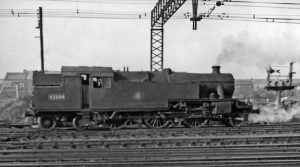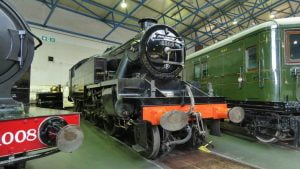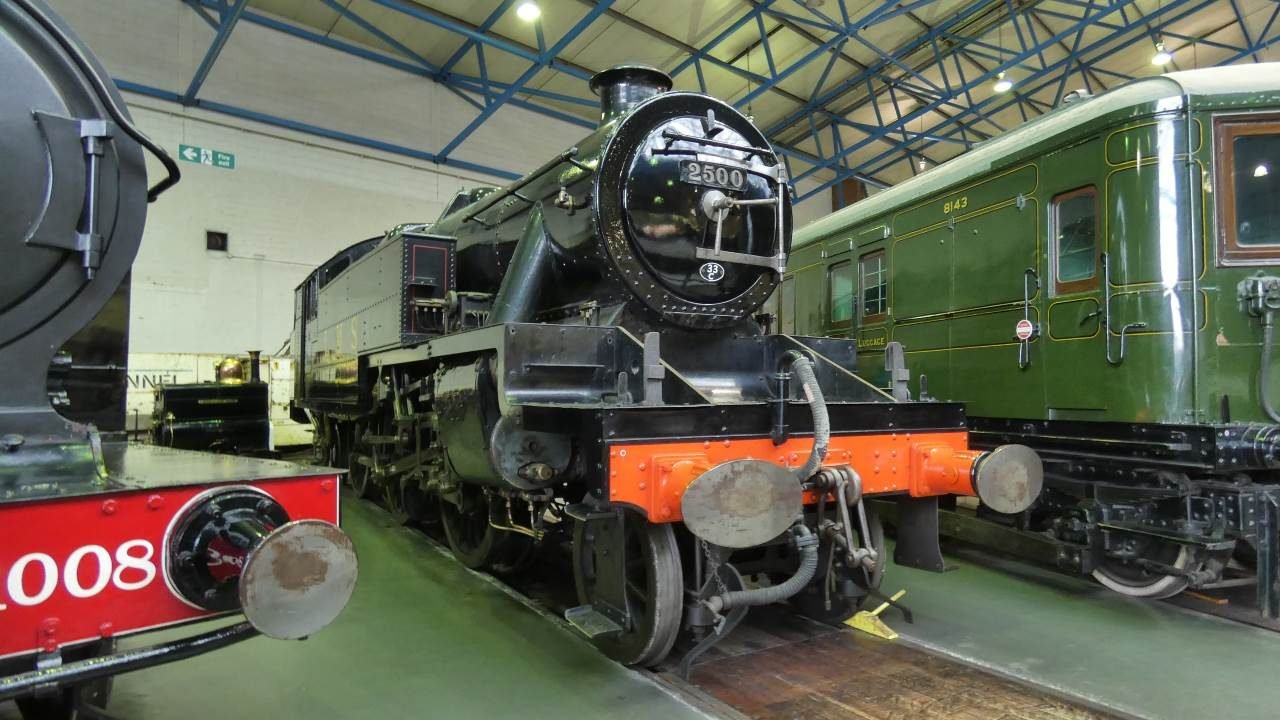Compact but fast, the 3-Cylindered 2-6-4 Tanks are some of the first engines designed by William Stanier for the London, Midland & Scottish Railway (LMS).
They are the topic of this week’s Sole Survivor. After looking at their history we will see how preservation for the last member left has turned out.
LMS Stanier 3-Cylindered 2-6-4 Tanks
Shortly after his arrival to the LMS, Stanier started the long scheme of equipping the railway with a modern fleet of steam locomotives, suitable for both current and future traffic needs.
One area of the UK’s largest railway company that required new motive power was the London, Tilbury and Southend Railway (LTSR). To address the need for engines here, Stanier produced the 3-Cylindered 2-6-4 Tanks.

Design and Production Series
The LTSR was dominated by busy commuter trains, with passengers heading from areas of Essex and Barking into and out of London Fenchurch station. The short distances between stations and heavy loads, therefore, had to be hauled by fast and powerful engines.
This lead to a 3-cylinder layout being incorporated into the design, as this gave the class fast acceleration.
Also for this route, a tank engine was more practical than a tender engine. A common practice on the GWR, where Stanier worked before the LMS, was the use of taper boilers, which Stanier used in these tanks.
The basic dimensions for the class include: 2-6-4 wheel arrangement (coupled wheels – 5 foot (ft) 9 inch (in), leading bogie – 3ft 3 1/2in and trailing truck – 3ft 3 1/2 in), LMS type 4C boiler pressed at 200 lbf/in2, three cylinders (one inside, two outside) (16in diameter and 26in stroke), total weight came in at 92.25 long tons and a tractive effort of 24,598 lbf.
Derby works constructed all 37 engines in two batches, details can be found below:
- Lot 102 – No.2500 to 2504 (1934) – 5 engines
- Lot 116 – No.2505 to 2536 (1934) – 32 engines

Performance in Service
The whole class were allocated to hauling train services on the LTSR, which they were perfect at. Footplate crews liked the class as they always gave a good performance.
Decline and Withdrawal
Initially, 45 engines were ordered to be built but this was later changed and production was stopped at 37. The reason for this was Stanier in 1935 had started to build a 2-Cylinder version of the 4P 2-6-4Ts. The 2-Cylinder arrangement had the advantage over the 3-Cylinder layout as they easier to build and maintain, as both cylinders were on the outside of the engines with easy access. With little difference in performance, the 2-Cylinder engines were chosen over the 3-Cylinder ones.
Despite this, the 3-Cylinders remained the main engines on the LTSR right up until Diesel Multiple Units (DMUs) and Electric Multiple Units (EMUs) were introduced in the early 1960s. Over the two year period between 1960 and 1962, the whole class was withdrawn from service.

Preservation

Although withdrawal came early on, one member of the class, the first to be built, was saved for preservation and now apart of the National Collection at the National Railway Museum York.
This engine, No.2500, has mostly spent its years in the National Collection as a static display but has been in steam for a small amount of time. There are currently no plans to restore the tank, and its displayed in LMS Lined Black with “LMS” on water tanks.
We hope you have enjoyed this week’s Sole Survivor. Next week will see the next instalment of the Lost Class series be released, on a Southern Railway class. Missed last week’s Class Information? Don’t worry, as you can read it here.
Where Next?
News Homepage
For the Latest Railway News
RailAdvent Online Shop
Framed Prints, DVD’s / Blu-Ray’s and more
LocoStop – The RailAdvent Community
Come and share your railway pictures






Responses
I have a very specific memory of one of these 3-cylinder locos, 42534.
It must have been in August, 1960. I was trainspotting at Bedford Midland Rd – actually, my mum worked nearby, so I’d just come back from lunch at about 13.30. 42534 was standing in what was then platform 2 – it was a north facing bay, used by some Northampton trains and (presumably) by locals to Kettering – but these had finished by this time.
I walked up the platform and asked to cab the loco, and was promptly invited onto the footplate. I believe it was in transit either to or from Derby loco works (I have a few underlined in my old combined volume, and I’ve never been to the LTSR, not even to this day, so they must have been passing Bedford on a sort fortnightly basis, at a guess.)
Anyway, after 10 mins on the loco, I left to go over to the old platform 4/5, the closest to the avoiding lines – platform 4 was used by down stoppers. As I left, there was an up express pegged, and when I crossed the footbridge, I could see a diesel approaching. Now diesels in those days almost always meant 2 x D57xx Metro-Vicks on Manchester trains, and I shouted across to the driver of 42534 to help me get the number of the second locomotive. (I was only 8 years old, and the passed at about 75 mph)
Anyway, 20 second later what should appear but a brand-new D11, travelling (I guess now) at only about 50 mph on, I assume a test run.
It felt exciting at the time, but of course, it was merely the precursor to the end. Within a mere 12 months, what became Cl 45s had almost eliminated steam was on passenger turns on the Midland. I guess 2534 went within 12, maybe 18 months too.
Happy Days!
I have heard of a new book on the class from a friend but cannot find anything. Any ideas?
2500 spent many years at BRessingham
Do
[…] The LTSR was dominated by busy commuter trains, with passengers heading from areas of Essex and Barking into and out of London Fenchurch station. The short distances between stations and heavy loads, therefore, had to be hauled by fast and powerful engines. LMS Stanier 3-Cylindered 2-6-4 Tank steam locomotives – Sole Survivor […]
I reckon the steam must of been better than todays trains .
Not breaking down and not being late in them days
The smell of them is great and the sound must of been nice sight to see them
We wouldn’t say no to steam returning!
Brilliant
Many thanks, im glad you enjoyed the read 🙂
Great article on the Stanier LTSR 2-6-4T engines! I remember them well as a small boy n the late 1940s/early 1950s when we (my late brother and myself) were taken to the beach at Chalkwell for summer days out. Chalkwell was one of the earlier “safe” beaches cleared of all wartime detritus, and was a popular spot for young children. I recall after the excitement of the train journey, crossing from the arrival platform, over the footbridge, which led out towards the beach. We (my brother and I would often linger on the footbridge to watch the train’s departure onwards, the additional attraction being to become enveloped in smoke as the engine passed! We were not very technically astute at our young ages then, so many of the finer points would have been lost on us, but one thing that has always struck me from those times was the friendliness of the footplate crews, which seemed universal. To us obviously, the former LTSR was a ‘holiday’ line, that we associated with buckets and spades (metal, not plastic like everything these days)! The coaching stock as far as I can recall, was all maroon LMS non-corridor, almost undoubtedly of the pre-war era. The route, following the South Essex estuary from London, was, I imagine, fairly undemanding for the crews on account of the fairly level terrain, so there was little in the way of vocal response from up front at the chimney, but nonetheless it was a pleasant journey, in those days across agricultural and dairy farmland, which to us Londoners afforded a pleasant and novel outlook from the carriage windows.
Hi Bob,
Many thanks for your comment.
I’m really glad you enjoyed this weeks Sole Survivor and for telling us of your stories. It sounds like a great time was had.
Regards,
Michael